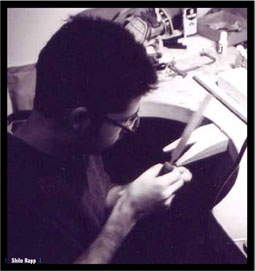By Paddy Kamen
 Careers that are nurtured in the heart of a family business are rare these days, especially when the product is artisanal. Shilo Rapp is a rare bird indeed, one who took a circuitous route that led to his emerging position as one of Canada’s foremost designers.
Careers that are nurtured in the heart of a family business are rare these days, especially when the product is artisanal. Shilo Rapp is a rare bird indeed, one who took a circuitous route that led to his emerging position as one of Canada’s foremost designers.
He began by making pens, of all things, at age 17. “Conventional education wasn’t working for me. I had always been mechanically inclined and there is nowhere to learn how to make a fountain pen, so I started studying machining and jewelry making in one-off courses. I did apprenticeships with local and international jewelers and silversmiths, and studied tool and die machining. I built my skill set according to my needs as they emerged.”
Shilo was supported in these endeavours by his father, Mel Rapp, and Mel’s wife Julia. Mel is the owner of Toronto-based retail store Rapp Optical, and a frame designer in his own right. Shilo notes that Mel and Julia supported him in discovering how to best use his innate strengths. “I was working in the store evenings and weekends during my high school years and Mel carried high-end fountain pens, in addition to eyewear. I didn’t know what I wanted to do and he steered me in the direction of learning how to make them. It turned into a full-time thing and I left school. He also enrolled me in my first jewelry-making course. From there it was a domino effect in that I became obsessed with how things are made.”
One of the most impressive things about Mel and Shilo is that they are incredibly open to experimentation. “That’s where the learning happens,” says Shilo. “In the beginning, I didn’t know how to make pens; nor did we know how to manufacture frames.”
They certainly do now: in 2006, a joint business venture involving Mel, Julia and Shilo was launched as Rapp Eyewear. Mel oversees the business, Julia handles the colour aspect of design, along with fashion projections, and Shilo is the lead designer of shapes and the technical head of manufacturing. “I am in no way responsible for the success of Rapp Eyewear,” says Shilo. “Both Mel and Julia have a wealth of knowledge about the eyewear industry and Mel was designing frames long before I came on board. He casts a big shadow and his designs are still inspiring to me.”
Mel says, “Shilo wasn’t ordained as a designer, he worked hard for 12 years before I even told people what he was doing for our business. He had to pay his dues. Of course I am subjective, but I think he is one of the best.”
The proof of Shilo’s success as a designer is that Rapp Eyewear frames sell competitively alongside those from other leading-edge designers in the Rapp Optical store, where prototypes are also consumer tested. The company sells its frames around the world, showing them annually in New York and Paris, taking orders based on samples and making the frames when they return from the show. “We don’t keep stock,” notes Mel.
Technical innovation is a hallmark of Rapp Eyewear. They have an intensely perfectionist ethic, having (as just one example) worked for years just to refine their riveting process and get the correct pantoscopic tilt.
“Our success has been born out of technical limitations,” notes Shilo. “In the early days we didn’t have the industry-specific machinery required to produce eyewear. We developed and designed our own unique fixtures that attach to machines to help us achieve specific goals; and we’ve made mistakes. For example, we purchased a bridge bump machine and found out it was worse than what we were already using. So we created a new way of making bridge bumps, one with a zero rejection rate. This innovation has also contributed to the signature look of our frames.”
The finish on Rapp frames is also distinctive. “Our acetate has not gone through a mass tumbling process,” says Shilo. “We do it by hand. The front and inside of the acetate has a directional matte finish and is not high gloss. Only the edges are glossy. Our edges are very crisp, with no rounding. Once the front is machined it is truly a hand-finished product: no tumbler. A Rapp frame is unique and recognizable on the street.”
The mantle of ‘designer’ is taking some getting used to for Shilo Rapp. “I have shied away from calling myself that. I am more obsessed with how to make things.”
When asked what his goal is for Rapp Eyewear, Shilo responds: “The goal is to have a beautiful Canadian-made frame that sells with the best of them.”
With Rapp Eyewear frames selling big time into Japan, Korea, and China – markets better known for exporting than importing – in addition to France, Israel, Holland, Spain, Australia and the U.S., there is no doubt that Shilo Rapp is achieving his goal and will, over time, become more used to the accolades that accrue to high achievers in eyewear design.







